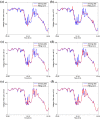Energy-Efficient Control with Harvesting Predictions for Solar-Powered Wireless Sensor Networks
- PMID: 26742042
- PMCID: PMC4732086
- DOI: 10.3390/s16010053
Energy-Efficient Control with Harvesting Predictions for Solar-Powered Wireless Sensor Networks
Abstract
Wireless sensor networks equipped with rechargeable batteries are useful for outdoor environmental monitoring. However, the severe energy constraints of the sensor nodes present major challenges for long-term applications. To achieve sustainability, solar cells can be used to acquire energy from the environment. Unfortunately, the energy supplied by the harvesting system is generally intermittent and considerably influenced by the weather. To improve the energy efficiency and extend the lifetime of the networks, we propose algorithms for harvested energy prediction using environmental shadow detection. Thus, the sensor nodes can adjust their scheduling plans accordingly to best suit their energy production and residual battery levels. Furthermore, we introduce clustering and routing selection methods to optimize the data transmission, and a Bayesian network is used for warning notifications of bottlenecks along the path. The entire system is implemented on a real-time Texas Instruments CC2530 embedded platform, and the experimental results indicate that these mechanisms sustain the networks' activities in an uninterrupted and efficient manner.
Keywords: energy prediction; shadow detection; solar cells; wireless sensor network.
Figures























References
-
- Brunelli D., Minakov I., Passerone R., Rossi M. Smart monitoring for sustainable and energy-efficient buildings: A case study; Proceedings of the 2015 IEEE Workshop on Environmental, Energy and Structural Monitoring Systems (EESMS); Trento, Italy. 9–10 July 2015; pp. 186–191.
-
- Cheng B., Cheng Xin., Zhai Z., Zhang C., Chen J. Web of things-based remote monitoring system for coal mine safety using wireless sensor network. Int. J. Distrib. Sens. Netw. 2014 doi: 10.1155/2014/323127. - DOI
-
- McCullagh J.J., Galchev T., Peterson R.L., Gordenker R., Zhang Y., Lynch J., Najafi K. Long-term testing of a vibration harvesting system for the structural health monitoring of bridges. Sens. Actuators A Phys. 2014;217:139–150. doi: 10.1016/j.sna.2014.07.003. - DOI
-
- Nikolidakis S.A., Kandris D., Vergados D.D., Douligeris C. Energy efficient automated control of irrigation in agriculture by using wireless sensor networks. Comput. Electron. Agric. 2015;113:154–163. doi: 10.1016/j.compag.2015.02.004. - DOI
LinkOut - more resources
Full Text Sources
Other Literature Sources

